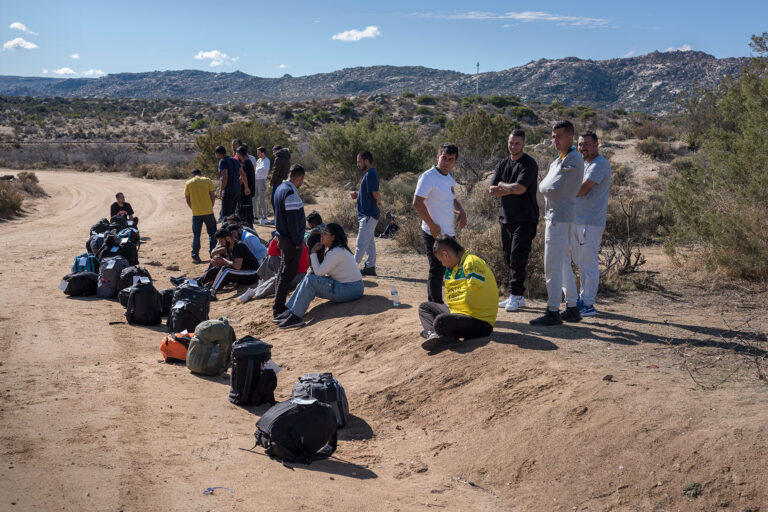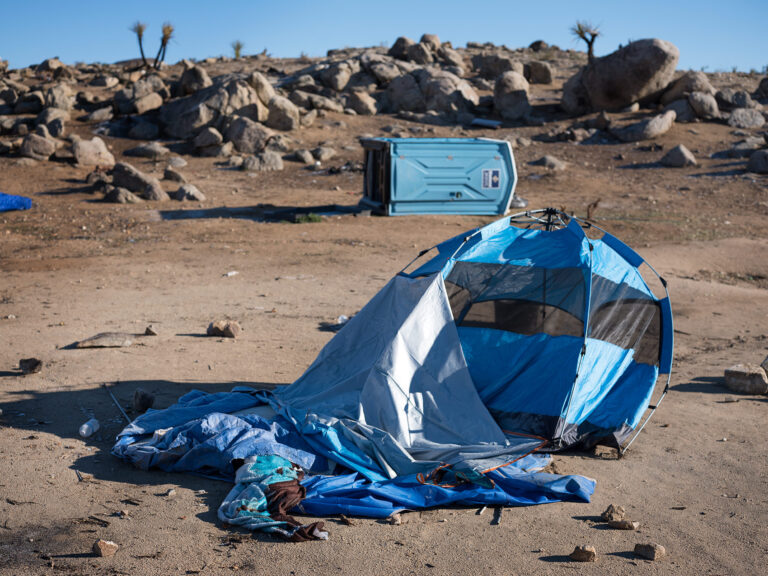Borderlands
2024
Jacumba, California. In this small community located in the Pacific Coast Ranges, I climb the wall that winds through and marks off this border territory. For the first time, my gaze and my camera take in its contours, its roughness and dryness. The uneven terrain on which the wall rises up intermittently is where people smugglers drop off clandestine migrants. At the foot of a nearby hill I come across an opening leading to a beaten-earth path. Clothing caught on barbed wire, like the skin or feathers inexorably shed by moulting animals, attests to the difficult transit toward this longed-for refuge. This escape from the past, however, does not ensure that migrants who arrive here will have a future. For those seeking to get into the United States, the voyage is hazardous; indeed a good many of them vanish on the way1. Desert crossings are dangerous and hundreds of deaths have been recorded at the border. In Mexico, many are kidnapped, detained and held for ransom. Rape is a common occurrence and there are indications of child trafficking2.
In recent years there has been a sharp rise in clandestine immigration into the United States. With the reopening of the border in 2021, after its closure during the pandemic, the country has had to manage a huge influx of asylum seekers. In early 2024, a young nursing student was killed by an illegal foreign national in the State of Georgia3. This unforeseen incident brought the question of migration brutally back into the forefront of current political discourse. The increase in the flow of migrants has given rise to tensions among the American population, which is deeply divided on the issue. Some people talk of a humanitarian crisis while others feel threatened by these illegal crossings and consider them a veritable “invasion.” Cartels and other gangs arrange these clandestine crossings, going even so far as advertising them on social media as a way of picking up potential clients. Some of the resulting criticism also claims that the crisis may be underpinned by political manoeuvring, that the inclusion of the new arrivals in census figures could significantly impact State representation in the Electoral College and in the House of Representatives4. Since the problem stems from many factors, resolving it effectively will require addressing the deep roots of these population movements in poverty, violence and corruption.
Day after day, night after night, furtive escapes follow in quick succession. A group of young migrants has just been intercepted near Old Highway 80. I take the opportunity to strike up a conversation with the border guards, who are overrun and visibly overwhelmed. The barbed wire was cut and the new gap has to be controlled. This is relentless, the guards tell me, it’s become a kind of daily routine for them as new people show up. Later, vans will come to pick them up and take them to triage centres. I encounter some worried gazes and exchange a few looks and nods with the people around me; soon this steel wall stretching out of sight will be the only thing left. At the foot of the wall I pick up a passport with the pages torn out of it, identity cards and a photo of a nameless family.
**
1 – « Des migrants plus déterminés que jamais » Libre Média, 21 février 2024
2 – “Report finds more than 340 migrant kids were sent to live with nonrelatives who sponsored other children” NBC News, June 2, 2023
3 – “Killing of Laken Riley” Wikipedia
4 – “Experts warn illegal immigrants account for 22 seats in the House” State of the union, February 18, 2024
FRANÇAIS
Jacumba, Californie. Dans cette petite localité de la chaîne côtière du Pacifique, j’arpente le mur qui serpente tout en délimitant ce territoire frontalier. Pour la première fois, mon regard, autant que ma caméra, en examine les contours, les aspérités, l’aridité. Le relief accidenté depuis lequel se dresse le mur, en discontinu, devient l’endroit choisi par les passeurs pour y déposer les clandestins. Au pied d’une colline adjacente, je découvre une brèche, puis un sentier de terre battue, piétinée. Des vêtements accrochés aux barbelés, telle une inexorable mue, témoignent de cette transition difficile vers cette terre d’accueil tant convoitée. Toutefois, cette arrachée au passé ne leur garantit pas un avenir. Pour les migrants cherchant à atteindre les États-Unis, le voyage est risqué, puisque bon nombre d’entre eux disparaissent en chemin1. La traversée du désert est périlleuse et des centaines de décès sont recensés à la frontière. Au Mexique, plusieurs sont enlevés, détenus et rançonnés. Les viols ne sont pas rares et l’on soupçonne l’existence d’un trafic d’enfants2.
L’immigration clandestine connaît une forte hausse aux États-Unis depuis quelques années. Avec la réouverture des frontières en 2021, fermées lors de la pandémie, le pays doit gérer une arrivée massive de demandeurs d’asile. Au début de l’année 2024, une étudiante est tuée par un ressortissant en situation irrégulière dans l’état de la Géorgie3; cet événement inattendu ramène brutalement la question migratoire au premier plan de l’actualité politique. Cette augmentation du flux migratoire suscite des tensions chez la population américaine, particulièrement divisée à ce sujet. Une partie la considère essentiellement comme une crise humanitaire, l’autre se sent menacée par ces passages illégaux, les qualifiant même de véritable « invasion ». Des gangs et des cartels organisent ces passages clandestins, allant même jusqu’à s’afficher sur les médias sociaux afin de dénicher des clients. Des critiques avancent aussi que des manigances politiques pourraient se tramer sous cette crise, arguant que l’inclusion de nouveaux arrivants dans le décompte du recensement impacterait significativement la représentation des États au Collège électoral, ainsi qu’à la Chambre des représentants4. Le problème étant multifactoriel, le corriger efficacement, exigerait d’endiguer les causes profondes de ces transhumances prenant racine dans la pauvreté, la violence et la corruption.
Jour après jour, nuit après nuit, les évasions furtives se succèdent. Près de la route 80, un groupe de jeunes migrants, vient d’être intercepté. Je saisis l’occasion d’en discuter avec les gardes frontaliers, débordés et visiblement dépassés. Les barbelés ont été sectionnés, il faudra surveiller cette nouvelle issue. C’est en continu me disent-ils, c’est devenu une sorte de routine pour nous, chaque jour de nouveaux arrivants se présentent ici. Plus tard, des camionnettes viendront les chercher pour les transporter vers des centres de tri. Je croise quelques regards inquiets, nous échangeons quelques signes, bientôt il ne restera que ce mur d’acier, à perte de vue. Au pied du mur, je ramasse un passeport aux pages arrachées, des cartes d’identités et la photo d’une famille inconnue.
































